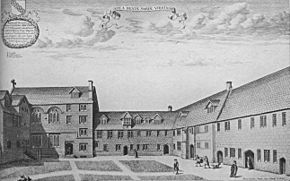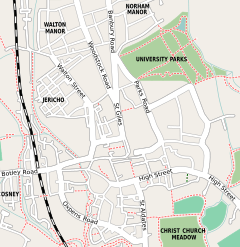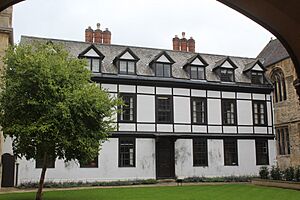St Mary Hall, Oxford facts for kids
Quick facts for kids St Mary Hall |
|
|---|---|
 |
|
| University | University of Oxford |
| Location | High Street |
| Coordinates | 51°45′08″N 1°15′13″W / 51.7522°N 1.2536°W |
| Latin name | Aula Beatae Mariae Virginis |
| Established | 1326 (as part of Oriel College) 1545 (as an independent hall) |
| Closed | 1902 (incorporated into Oriel College) |
| Named for | Church of St Mary the Virgin |
| Principal | see below |
| Map | |
St Mary Hall was a special kind of student home and learning center at the University of Oxford a long time ago. It was like a smaller, independent college. For many years, from 1326 to 1545, it was connected to Oriel College. But then, it became completely independent in 1545. It stayed independent until 1902, when it joined Oriel College again.
Contents
What is the History of St Mary Hall?
In 1320, a person named Adam de Brome became the leader of the Church of St Mary the Virgin. He was given a house called St. Mary Hall, which was on the main street in Oxford. This house later became part of the university.
How did St Mary Hall become part of Oriel College?
Oriel College bought St. Mary Hall in 1326. Another nearby hall, Bedel Hall, was given to Oriel in 1455. These two halls, along with St. Martin's Hall, were used as extra places for students from Oriel College to live and study.
In the early 1500s, students who received special scholarships from Oriel College often stayed in St Mary Hall and Bedel Hall. Around this time, St Mary Hall and Bedel Hall joined together. St. Mary Hall then started to become its own separate place.
When did St Mary Hall become independent?
In 1545, a bishop named Bishop Longland ordered that St Mary Hall should be separate from Oriel College. The door connecting the two places was even blocked! After this, St Mary Hall hired its own teachers. Sometimes, it even had more students than Oriel College itself.
In 1552, there were 18 members at St. Mary Hall, not including its leader, called the Principal. The Principals of St Mary Hall were usually also important members of Oriel College until 1656. By 1875, St. Mary Hall had grown quite a bit, with 60 undergraduate students. This was a large number for a college at that time.
How did St Mary Hall rejoin Oriel College?
St. Mary Hall was basically owned by its Principal, who was also the Vicar (a type of priest) of St Mary's Church. The last Principal, Drummond Percy Chase, made an agreement with Oriel College. This agreement said that when he died, St Mary Hall would become part of Oriel College. He passed away in 1902, and that's when St Mary Hall officially joined Oriel College again.
Some old agreements from when St. Mary Hall was separate still exist today. For example, the Vicar of St Mary's Church still has the right to eat meals at Oriel College.
Today, the area known as St. Mary's Quad, or the 'third quadrangle', at Oriel College uses three parts of the old St. Mary Hall buildings. The Principal's house was taken down to build the Rhodes Building. This new building was finished in 1911.
Who were the Principals of St Mary Hall?
The Principal was the head or leader of St Mary Hall. Here is a list of some of the people who held this important role:
- Adam de Brome
- 1532–1537 John Rixman
- 1546–1550 Morgan Phillips
- 1556–1561: William Allen, who later became a Cardinal
- 1656–1660 Thomas Cole
- 1664–1689: Joseph Crowther
- 1689–1712: William Wyatt
- 1712–1719: John Hudson
- 1719–1764: William King
- 1764–1801: Thomas Nowell
- 1801–1815: Phineas Pett
- 1815–1833: John Dean
- 1833–1848: Renn Dickson Hampden
- 1848–1857: Philip Bliss
- 1857–1902: Drummond Percy Chase
Who are some famous former students?
Many notable people studied at St Mary Hall. Here are a few:
- John Ball (Puritan), who earned his Bachelor of Arts degree in 1608.
- William Henry Charsley, who became the Master of Charsley's Hall, Oxford.
- Edward Craggs-Eliot, 1st Baron Eliot, who joined in 1742.
- Brajendranath Dey, who worked in the Indian Civil Service, joined in 1874.
- Thomas Harriot, a famous astronomer, mathematician, and translator from the 1500s.
- Theodore Hook, an author who joined but did not live there.
- Robert Hues, who earned his Bachelor of Arts degree in 1578.
- John Hunter, who joined in 1755.
- Sir Christopher Hatton, who was a very important judge in England.
- Robert Parsons, a leading Jesuit priest.
- George Sandys
- John Marston (poet)
- Thomas Jackson Rev, who graduated with a BA in 1834 and an MA in 1837.
See also
 In Spanish: St Mary Hall, Oxford para niños
In Spanish: St Mary Hall, Oxford para niños




